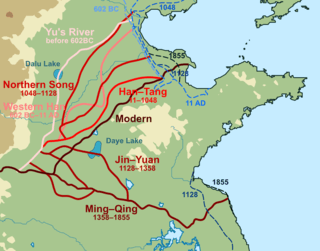1034 Yellow River flood
The 1034 Yellow River flood (traditional Chinese: 1034年黃河洪水; simplified Chinese: 1034年黄河洪水; pinyin: 1034 nián huánghé hóngshuǐ)[lower-alpha 1] was a natural disaster along China's Yellow River originating in a burst fascine following heavy rainfall at Henglong in the territory of the Northern Song. The flood divided the Yellow River from its previous course into three more northerly channels meeting the Chihe, You, and Jin.
 The Yellow River's course at the time (marked Han-Tang) began to be altered by the river's flooding in 1034 | |
| Date | around July 1034 |
|---|---|
| Location | Modern-day northern Shandong and southern Hebei |
| Cause | Heavy rainfall leading to the bursting of a fascine |
| Deaths | unknown |
| Property damage | Significant damage to agricultural regions around Dezhou and Bozhou; decreased revenues in northern provinces of the Northern Song |
| 1034 Yellow River flood | |||||||||||||||||||
|---|---|---|---|---|---|---|---|---|---|---|---|---|---|---|---|---|---|---|---|
 "1034 Yellow River flood" in Simplified (top) Chinese characters, and Traditional (bottom) Chinese characters | |||||||||||||||||||
| Traditional Chinese | 1034年黃河洪水 | ||||||||||||||||||
| Simplified Chinese | 1034年黄河洪水 | ||||||||||||||||||
| |||||||||||||||||||
The Yellow River's new channels caused flooding in the rich northern regions of Dezhou and Bozhou, as well as reducing revenues in the northern regions of the Northern Song. The Yellow River flooded once again in 1048, causing the river's course to move northward past the southern Hebei-Shandong region, where it had led into the sea before.
Background
In the rule of the Northern Song dynasty over China, there were four major floods of the Yellow River to note. The first one of these floods occurred before the year in 983, while the other three occurred after 1000 CE in 1019, 1034, and 1048 respectively.[2] Before the 1034 flood, the Yellow River followed the same route it had since the year 11 CE.[3] In order to maintain protection from the heavy annual rains around July, a system of fascines were constructed along much of the river's path in areas controlled by the Northern Song.[4]
Flood
During a period of intense rainfall in July 1034, a fascine outside at Henglong burst, causing a massive flow of water from the Yellow River away from the course it had previously followed and been directed into. This diversion created three new channels that connected into the Chihe, You, and Jin rivers alongside the river's original outlet into the Bohai Sea. The amount of water brought into the Chihe, You, and Jin rivers stirred up massive amounts of sediment that were carried downriver.[5]
Aftermath
Unlike the controlled path of the Yellow River previously, the river's newly diverted path caused extensive flooding in the Dezhou and Bozhou regions (of modern-day Shandong). The large amounts of sediment picked up when the Yellow River's waters entered the Chihe, You, and Jin rivers also caused major economic damage to the northern provinces of the Northern Song where the tributary rivers led to. Under the rule of Renzong, an emperor known for his modesty, the Song worked for five years futilely attempting to restore the Yellow River's previous course.[5][6]
This project used over 35,000 employees, 100,000 conscripts, and 220,000 tons of wood and bamboo in a single year – before the project was abandoned in 1041.[7] Only seven years after the project to restore the river's course was ended, the Yellow River flood of 1048 caused the river to move much further north, meaning that the Chihe, You, and Jin rivers were no longer a threat to agriculture around modern-day Hebei and Shandong. Due to the flooding of agriculture in Dezhou and Bozhou, as well as the sediments carried along the Yellow River's three new tributary rivers, the 1034 flood was recorded as reducing the revenues of the northern provinces by half. The economic consequences of the first flood however were not fully repaired by the time that the second flood came, leading to yet more devastation in the northern provinces of the Northern Song. [8]
See also
Notes and references
Notes
- The period of time surrounding both the 1034 Yellow River flood and the succeeding 1048 Yellow River flood is generally referred to as the Song Dynasty period of "two" rivers[1]
References
- z09information 2011.
- Xu 2012, p. 4-5.
- Xu 2012, p. 4.
- Zhang & Chen 2013, p. 71.
- Shi 2011, p. 2-4.
- Kui 2014, p. 1.
- Elvin & Liu 1991, p. 555.
- Elvin & Liu 1991, p. 554-556.
Bibliography
- Xu, Weili (2012). 黄河自然灾害汇总 [Summary of Natural disasters in the Yellow River] (in Chinese) – via Doc 88.
- Zhang, Qin; Chen, Shiyue (March 2013). "历史时期黄河下游地区的洪水及其对东平湖变迁的影响" [Flooding in the Lower Yellow River and its Influence on the Change of Dongping Lake During the Historical Period]. Journal of Liaocheng University (Nat. Sci.) (in Chinese). 26 (1) – via Doucin.
- Shi, Zhangxing (November 2011). "黄河流域主要泥沙汇堆积过程及输沙量的长期变化". Yellow River (of the People's Republic) (in Chinese). 36 (11) – via Doc 88.
- z09information (23 Nov 2011). "泛滥的黄河——历史上的六次大改道" [The Flooding of the Yellow River - Six Great Changes in History]. 360doc (in Chinese). Retrieved 1 Nov 2019.
- Elvin, Mark; Liu, Ts'ui-jung (1998-01-13). Sediments of Time: Environment and Society in Chinese History. Cambridge University Press. ISBN 9780521563819.
- Kui, Daming (2014). "宋仁宗:我只想做一回主" [Song Renzong: I Just Want to be a Lord Once]. The Hundred Family Forum (in Chinese). 22 – via Longyuan Periodical Network.